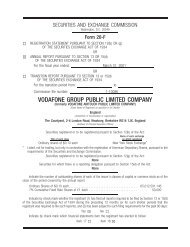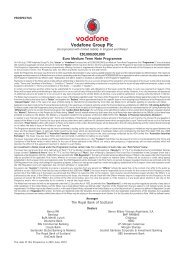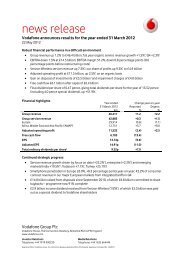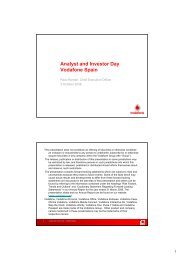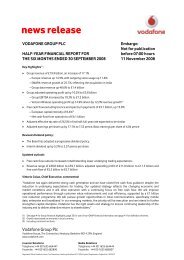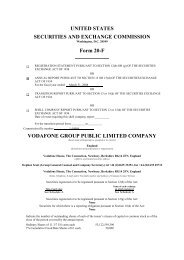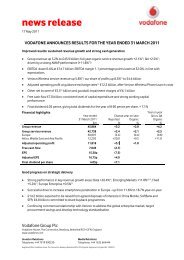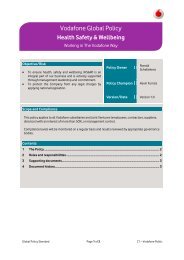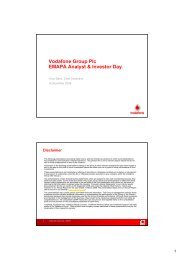Create successful ePaper yourself
Turn your PDF publications into a flip-book with our unique Google optimized e-Paper software.
•<br />
•<br />
Access & transmission network<br />
Fixed broadband networks<br />
Modem<br />
Private corporate networks<br />
Router<br />
2G/3G mobile networks<br />
Access<br />
transmission<br />
infrastructure<br />
(e.g. microwave, leased<br />
line or DSL)<br />
The Packet Switched domain allows customers to use<br />
data services. Its key nodes are responsible for a variety of<br />
functions, such as <strong>the</strong> delivery of data packets to and from<br />
mobile devices within a geographical service area, setting<br />
up data connections and providing <strong>the</strong> gateway between<br />
<strong>the</strong> <strong>Vodafone</strong> network and external data networks, including<br />
<strong>the</strong> internet and customers’ corporate networks.<br />
The IP Multimedia Subsystem (“IMS”) domain is <strong>the</strong> first step<br />
of a wider evolutionary path from <strong>the</strong> current core network<br />
to an all internet protocol (“IP”) next generation network.<br />
It enables delivery of advanced multimedia services, both<br />
mobile and fixed, leveraging <strong>the</strong> flexibility and effectiveness<br />
of internet technologies. IMS is expected to be a key element<br />
in <strong>the</strong> future infrastructure to support <strong>Vodafone</strong>’s total<br />
communications strategy, exploiting <strong>the</strong> technology of<br />
convergence between <strong>the</strong> mobile telecommunications and<br />
<strong>the</strong> internet world.<br />
If <strong>the</strong> voice call or data transmission is intended for delivery<br />
to ano<strong>the</strong>r device which is not on <strong>the</strong> <strong>Vodafone</strong> network in<br />
<strong>the</strong> same country, <strong>the</strong> information is transferred through a<br />
public or private fixed line telephone network or <strong>the</strong> internet.<br />
Mobile network technology<br />
2G<br />
<strong>Vodafone</strong> operates 2G networks in all its mobile operating<br />
subsidiaries, through Global System for Mobile (“GSM”) networks,<br />
offering customers services such as voice, text messaging and<br />
basic data services. In addition, all of <strong>the</strong> Group’s controlled<br />
networks operate General Packet Radio Services (“GPRS”), often<br />
referred to as 2.5G. GPRS allows mobile devices to be used for<br />
sending and receiving data over an IP based network, enabling<br />
wireless access to data networks like <strong>the</strong> internet.<br />
Core network O<strong>the</strong>r networks<br />
Service<br />
platforms<br />
IMS<br />
Packet<br />
switched<br />
Circuit<br />
switched<br />
Fixed line<br />
operators<br />
Internet<br />
O<strong>the</strong>r<br />
mobile<br />
operators<br />
Base station DSLAM<br />
The GPRS data service offering includes internet and email<br />
access, allowing <strong>the</strong> customer to always be connected at<br />
download speeds slightly below a dial-up modem. In some<br />
markets, <strong>Vodafone</strong> continues to fur<strong>the</strong>r evolve data speeds<br />
with 2G evolutions beyond GPRS capability.<br />
3G<br />
<strong>Vodafone</strong>’s 3G networks, operating <strong>the</strong> Wideband Code Division<br />
Multiple Access (“W-CDMA”) standard, provide customers with<br />
faster data access. <strong>Vodafone</strong> has expanded its service offering on<br />
3G networks with high speed internet and email access, video<br />
telephony, full track music downloads, mobile TV and o<strong>the</strong>r data<br />
services in addition to existing voice and data services.<br />
High speed packet access (“HSPA”)<br />
HSPA is a 3G wireless technology enhancement enabling<br />
significant increases in data transmission speeds. It allows<br />
increased mobile data traffic and improves <strong>the</strong> customer<br />
experience through <strong>the</strong> availability of 3G broadband services<br />
and significantly shorter data transfer times.<br />
High Speed Downlink Packet Access (“HSDPA”) has been widely<br />
deployed on <strong>Vodafone</strong> 3G networks at up to 3.6 Mbps (“Mega<br />
bits per second”) peak speed. In addition, starting in hotspots,<br />
<strong>the</strong> first upgrades to up to 7.2 Mbps peak speed have already<br />
started to be deployed in several operating subsidiaries. The<br />
figures are <strong>the</strong>oretical peak rates deliverable by <strong>the</strong> technology<br />
in ideal radio conditions with no customer contention for<br />
resources. This is providing customers with faster access<br />
speeds than historically experienced on 3G networks.<br />
<strong>Vodafone</strong> Group Plc Annual Report 2008 17




